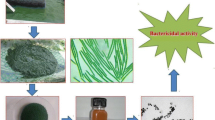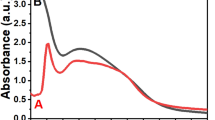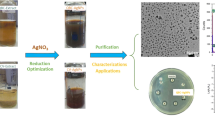Abstract
A novel approach for the green synthesis of silver nanoparticles (AgNPs) from aqueous solution of AgNO3 using culture supernatant of phenol degraded broth is reported in this work. The synthesis was observed within 10 h, and AgNPs showed characteristic surface plasmon resonance around 410 nm. Spherical nanoparticles of size less than 30 nm were observed in transmission electron microscopy. X-ray diffraction pattern corresponding to 111, 200, 220, and 311 revealed the crystalline nature of the as-formed nanoparticles. It was found that the colloidal solution of AgNP suspensions exhibited excellent stability over a wide range of ionic strength, pH, and temperature. The effect of pH and ionic strength indicated that stabilization is due to electrostatic repulsion arising from the negative charge of the conjugate proteins. The AgNPs showed highly potent antimicrobial activity against Gram-positive, Gram-negative, and fungal microorganisms. The as-prepared AgNPs showed excellent catalytic activity in reduction of 4-nitrophenol to 4-aminophenol by NaBH4. By manufacturing magnetic alginate beads, the reusability of the AgNPs for the catalytic reaction has been demonstrated.







Similar content being viewed by others
References
Ahmad A, Mukherjee P, Senapati P, Mandal D, Khan MI, Kumar R, Sastry M (2003a) Extracellular biosynthesis of silver nanoparticles using the fungus Fusarium oxysporum. Colloids Surf B 28:313–318
Ahmad A, Senapati S, Khan MI, Kumar R, Ramani R, Srinivas V, Sastry M (2003b) Extracellular synthesis of gold nanoparticles by novel alkalotoleran tactinomycete Rhodococcus species. Nanotechnol 14:824–828
Ai L, Yue H, Jiang J (2012) Environmentally friendly light-driven synthesis of Ag nanoparticles in situ grown on magnetically separable biohydrogels as highly active and recyclable catalysts for 4-nitrophenol reduction. J Mater Chem 22:23447–23453
APHA–AWWA–WPCF (1993) Standard methods for the examination of water and wastewater, 17th edn. American Public Health Association, Washington, DC
Bell KS, Philp JC, Aw DWJ, Christofi N (1998) The genus Rhodococcus. J Appl Microbiol 85:195–210
Boyd G, Yu ZH, Shen YR (1986) Photoinduced luminescence from the noble metals and its enhancement on roughened surfaces. Phys Rev B 33:923–937
Derjaguin B, Landau L (1941) Theory of the stability of strongly charged lyophobic sols and the adhesion of strongly charged particles in solutions of electrolytes. Acta Phys Chem URSS 14:633–662
Feng QL, Chen GQ, Cui FZ, Kim TN, Kim JO (2000) A mechanistic study of the antibacterial effect of silver ions on Escherichia coli and Staphylococcus aureus. J Biomed Mater Res 52:662–668
Finnerty WR (1992) The biology and genetics of the genus Rhodococcus. Annu Rev Microbiol 46:193–218
Gangula A, Podila R, Ramakrishna M, Karanam L, Janardhana C, Rao AM (2011) Catalytic reduction of 4-nitrophenol using biogenic gold and silver nanoparticles derived from Breynia rhamnoides. Langmuir 27:15268–15274
Gao Y, Ding X, Zheng Z, Cheng X, Peng Y (2007) Template-free method to prepare polymer nanocapsules embedded with noble metal nanoparticles. Chem Commun 36:3720–3722
Geize R, Dijkhuizen L (2004) Harnessing the catabolic diversity of rhodococci for environmental and biotechnological applications. Curr Opin Microbiol 7:255–261
Hayakawa K, Yoshimura T, Esumi K (2003) Preparation of gold–dendrimer nanocomposites by laser irradiation and their catalytic reduction of 4-nitrophenol. Langmuir 19:5517–5521
Jain PK, Huang X, El-Sayed IH, El-Sayed MA (2008) Noble metals on the nanoscale: optical and photothermal properties. Acc Chem Res 41(12):1578–1586
Jain N, Bhargava A, Majumdar S, Tarafdar JC, Panwar J (2011) Extracellular biosynthesis and characterization of silver nanoparticles using Aspergillus flavus NJP08: a mechanism perspective. Nanoscale 3:635–641
Jian Z, Xiang Z, Yongchang W (2005) Electrochemical synthesis and fluorescence spectrum properties of silver nanospheres. Microelectron Eng 77:58–62
Kalimuthu K, Deepak V, Ramkumarpandian S, Nellaiah H, Sangiliyandi G (2008) Extracellular biosynthesis of silver nanoparticles by the culture supernatant of Bacillus licheniformis. Mater Lett 62:4411–4413
Khot VM, Salunkhe AB, Thorat ND, Ningthoujam RS, Pawar SH (2013) Induction heating studies of dextran coated MgFe2O4 nanoparticles for magnetic hyperthermia. Dalton Trans 42:1249–1258
Li Q, Mahendra S, Lyon D, Brunet L, Liga M (2008) Antimicrobial nanomaterials for water disinfection and microbial control: potential applications and implications. Water Res 42:4591–4602
Li X, Lenhart JJ, Walker HW (2012) Aggregation kinetics and dissolution of coated silver nanoparticles. Langmuir 28:1095–1104
Magudapathy P, Gangopadhyay P, Panigrahi BK, Nair KGM, Dhara S (2001) Electrical transport studies of Ag nanoclusters embedded in glass matrix. Phys B 299:142–146
Marambio-Jones C, Hoek E (2010) A review of the antibacterial effects of silver nanomaterials and potential implications for human health and the environment. J Nanopart Res 12:1531–1551
Mayya KS, Patil V, Sastry M (1997) On the stability of carboxylic acid derivatized gold colloidal particles: the role of colloidal solution ph studied by optical absorption spectroscopy. Langmuir 13:3944–3947
McKenzie LC, Hutchison JE (2004) Green nanoscience. Chim Oggi 22:30–33
Mohammadian A, Shojaosadati SA, Rezaee MH (2007) Fusarium oxysporum mediated photogeneration of silver nanoparticles. Sci Iran 14:323–326
Morones JR, Elechiguerra JL, Camacho A, Holt K, Kour J, Ramirez JT, Yacaman MJ (2005) The bactericidal effect of silver nanoparticles. Nanotechnol 16:2346–2350
Murugadoss A, Chattopadhyay A (2008) A ‘green’ chitosan–silver nanoparticle composite as a heterogeneous as well as micro-heterogeneous catalyst. Nanotechnology 19:15603–15611
Nair CI, Jayachandran K, Shashidhar S (2008) Biodegradation of phenol. African J Biotechnol 7:4951–4958
Narayanan KB, Sakthivel N (2010) Biological synthesis of metal nanoparticles by microbes. Adv Colloid Interf Sci 156:1–13
Panigrahi S, Praharaj S, Basu S, Ghosh SK, Jana S, Pande S, Vo-Dinh T, Jiang H, Pal T (2006) Self-assembly of silver nanoparticles: synthesis, stabilization, optical properties, and application in surface-enhanced Raman scattering. J Phys Chem B 110:13436–13444
Pradhan N, Pal A, Pal T (2001) Catalytic reduction of aromatic nitro compounds by coinage metal nanoparticles. Langmuir 17:1800–1802
Rai M, Yadav A, Gade A (2009) Silver nanoparticles as a new generation of antimicrobials. Biotechnol Adv 27:76–83
Reddy AS, Chen CY, Chen CC, Jean JS, Chen HR, Tseng MJ, Fan CW, Wang JC (2010) Biological synthesis of gold and silver nanoparticles mediated by the bacteria Bacillus subtilis. J Nanosci Nanotechnol 10:6567–6574
Saifuddin N, Wong CW, Nur Yasumira AA (2009) Rapid biosynthesis of silver nanoparticles using culture supernatant of bacteria with microwave irradiation. J Chem 6:61–70
Sastry M, Lala N, Patil V, Chavan SB, Chittiboyina AG (1998) Optical absorption study of the biotin–avidin interaction on colloidal silver and gold particles. Langmuir 14:4138–4142
Shahverdi AR, Minaeian S, Shahverdi HR, Jamalifar H, Nohi AA (2007) Rapid synthesis of silver nanoparticles using culture supernatants of Enterobacteria: a novel biological approach. Process Biochem 42:919–923
Sharma NC, Sahi SV, Nath S, Parsons JG, Gardea-Torresde JL, Pal T (2007) Synthesis of plant-mediated gold nanoparticles and catalytic role of biomatrix-embedded nanomaterials. Environ Sci Technol 41:5137–5142
Singaravelu G, Arockiamary JS, Kumar VG, Govindaraju KA (2007) A novel extracellular synthesis of monodisperse gold nanoparticles using marine alga, Sargassum wightii Greville. Colloids Surf B 57:97–101
Siwach OP, Sen P (2009) Fluorescence properties of Ag nanoparticles in water, methanol and hexane. J Lumin 129:6–11
Stamplecoskie GK, Scaiano JC (2010) Light emitting diode irradiation can control the morphology and optical properties of silver nanoparticles. J Am Chem Soc 32:1825–1827
Verwey EJW, Overbeek JTG (1948) Theory of the stability of lyophobic colloids. Elsevier, Amsterdam
Zeta potential: An Introduction in 30 minutes M Instruments - Zetasizer Nano Serles Technical Note. MRK654-01, 2011
Acknowledgments
The authors are very grateful to Board of Research in Nuclear Sciences (BRNS) and Department of Science and Technology (DST), Delhi for providing the funds to carry out the research activities. Also, the authors are thankful to SAIF IIT-Bombay, Mumbai for TEM facility. The authors are very grateful to Department of Microbiology, Biochemistry and Biotechnology, Shivaji University, Kolhapur for allowing the use of facilities to carry out the experiments.
Author information
Authors and Affiliations
Corresponding author
Additional information
Responsible editor: Philippe Garrigues
Rights and permissions
About this article
Cite this article
Otari, S.V., Patil, R.M., Nadaf, N.H. et al. Green synthesis of silver nanoparticles by microorganism using organic pollutant: its antimicrobial and catalytic application. Environ Sci Pollut Res 21, 1503–1513 (2014). https://doi.org/10.1007/s11356-013-1764-0
Received:
Accepted:
Published:
Issue Date:
DOI: https://doi.org/10.1007/s11356-013-1764-0




